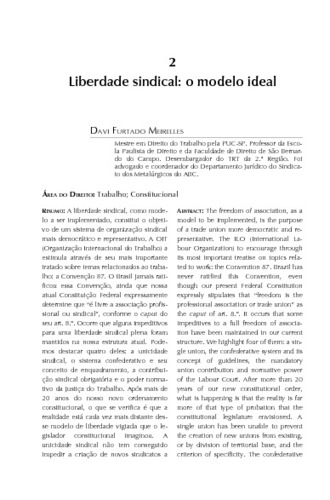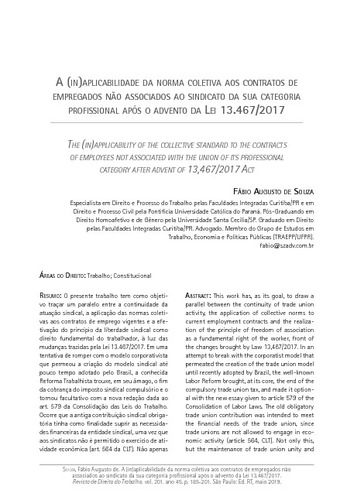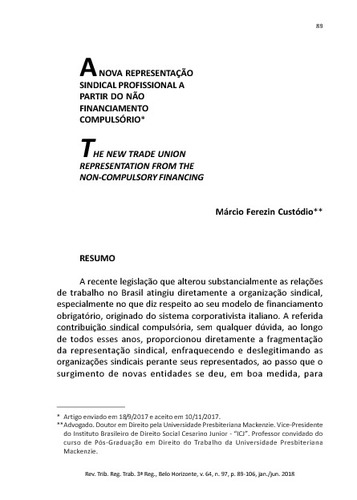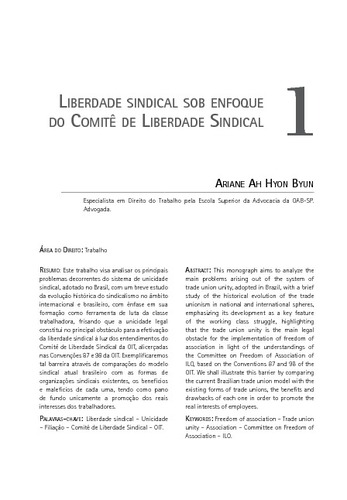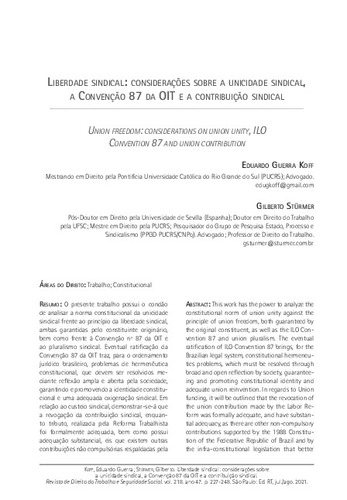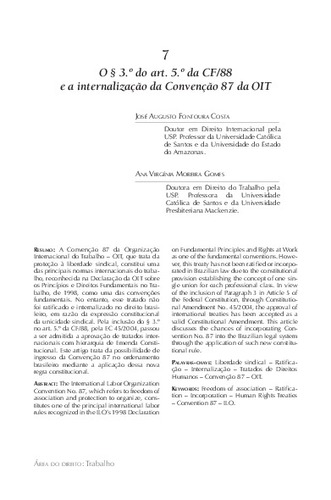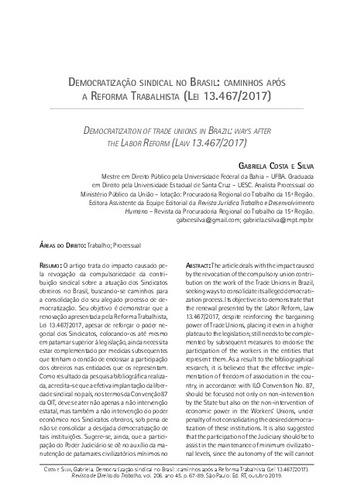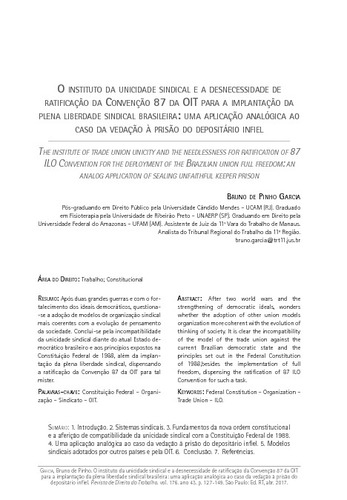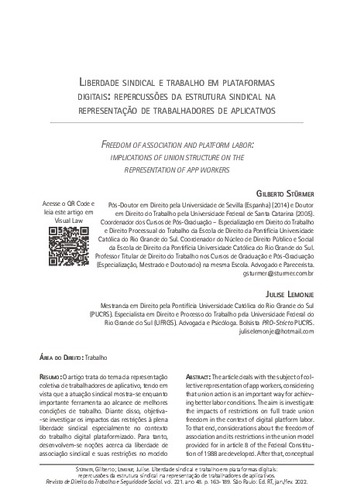Artigo de periódico
Liberdade sindical: o modelo ideal
| dc.contributor.author | Meirelles, Davi Furtado | |
| dc.date.accessioned | 2017-11-29T18:40:06Z | |
| dc.date.available | 2017-11-29T18:40:06Z | |
| dc.date.issued | 2010-03 | |
| dc.identifier.citation | MEIRELLES, Davi Furtado. Liberdade sindical: o modelo ideal. Revista de direito do trabalho, São Paulo, v. 36, n. 137, p. 45-75, jan./mar. 2010. | pt_BR |
| dc.identifier.citation | MEIRELLES, Davi Furtado. Liberdade sindical: o modelo ideal. Revista Ltr: legislação do trabalho, São Paulo, v. 74, n. 5, p. 542-552, maio 2010. | pt_BR |
| dc.identifier.uri | https://hdl.handle.net/20.500.12178/116278 | |
| dc.description.abstract | [por] A liberdade sindical, como modelo a ser implementado, constitui o objetivo de um sistema de organização sindical mais democrático e representativo. A OIT (Organização Internacional do Trabalho) a estimula através de seu mais importante tratado sobre temas relacionados ao trabalho: a Convenção 87. O Brasil jamais ratificou essa Convenção, ainda que nossa atual Constituição Federal expressamente determine que "é livre a associação profissional ou sindical", conforme o caput do seu art. 8º. Ocorre que alguns impeditivos para uma liberdade sindical plena foram mantidos na nossa estrutura atual. Podemos destacar quatro deles: a unicidade sindical, o sistema confederativo e seu conceito de enquadramento, a contribuição sindical obrigatória e o poder normativo da Justiça do Trabalho. Após mais de 20 anos do nosso novo ordenamento constitucional, o que se verifica é que a realidade está cada vez mais distante desse modelo de liberdade vigiada que o legislador constitucional imaginou. A unicidade sindical não tem conseguido impedir a criação de novos sindicatos a partir dos já existentes, quer por divisão de base territorial, quer por critério de especificidade. O sistema confederativo não impediu que as centrais sindicais se tornassem uma realidade legal em nosso país. A contribuição cogente, que tem natureza mais tributária do que sindical, perdeu a razão da sua manutenção e já se fala na sua substituição por uma contribuição negocial. E o poder normativo, que sofreu limitações extremas com a EC 45/2004, não mais desestimula o processo de negociação coletiva. Assim, com fundamento na Carta Constitucional, e independente da Convenção 87 da OIT, podemos afirmar que a liberdade sindical, como modelo ideal, já é uma realidade brasileira. | pt_BR |
| dc.description.abstract | [eng] The freedom of association, as a model to be implemented, is the purpose of a trade union more democratic and representative. The ILO (International Labour Organization) to encourage through its most important treatise on topics related to work: the Convention 87. Brazil has never ratified this Convention, even though our present Federal Constitution expressly stipulates that "freedom is the professional association or trade union" as the caput of art. 8º. It occurs that some impeditives to a full freedom of association have been maintained in our current structure. We highlight four of them: a single union, the confederative system and its concept of guidelines, the mandatory union contribution and normative power of the Labour Court. After more than 20 years of our new constitutional order, what is happening is that the reality is far more of that type of probation that the constitutional legislature envisioned. A single union has been unable to prevent the creation of new unions from existing, or by division of territorial base, and the criterion of specificity. The confederative system did not prevent the labor unions that became a legal reality in our country. The contribution Cogent, which has more tax nature of the union that has lost the reason for their maintenance and has spoken in its replacement by a contribution negotiation. And the legislative power, which has extreme limitations to the Constitutional Amendment 45/2004, no longer discourages the process of collective bargaining. Thus, based on the constitutional charter, and independent of Convention 87 of the ILO, we can say that the freedom of association, as ideal model, is a Brazilian reality. | pt_BR |
| dc.language.iso | pt_BR | pt_BR |
| dc.relation.ispartof | Revista de direito do trabalho: vol. 36, n. 137 (jan./mar. 2010) | pt_BR |
| dc.relation.ispartof | Revista Ltr: legislação do trabalho: vol. 74, n. 5 (maio 2010) | pt_BR |
| dc.subject | Liberdade sindical, Brasil | pt_BR |
| dc.subject | Sindicato, registro, Brasil | pt_BR |
| dc.subject | Contribuição sindical, Brasil | pt_BR |
| dc.subject | Enquadramento sindical, Brasil | pt_BR |
| dc.title | Liberdade sindical: o modelo ideal | pt_BR |
| dc.relation.references | Incisos I e II do art. 589; e arts. 592 e 593 da Consolidação das Leis do Trabalho, aprovada pelo Decreto-lei n. 5.452, de 1º de maio de 1943 | pt_BR |
| dc.type.genre | Artigo de periódico | pt_BR |
| dc.identifier.rvbisys | 000884480 | |
| dc.relation.ispartoflink | https://hdl.handle.net/20.500.12178/105317 | pt_BR |
| dc.relation.ispartoflink | https://hdl.handle.net/20.500.12178/104963 | pt_BR |
| dc.relation.referenceslink | http://www.lexml.gov.br/urn/urn:lex:br:federal:decreto.lei:1943-05-01;5452 | pt_BR |
Coleção
-
Artigos9527


